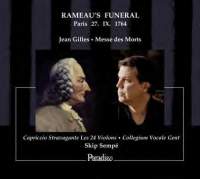Texte paru dans: / Appeared in: |
|
|
|
|
|
Reviewer: J.
F. Weber It is hard to believe that this famous work has not been reviewed here since the recording by Joel Cohen, made in 1989 (Fanfare 17:2). Two slightly newer versions had already been reviewed, Hervé Niquet’s (13:5) and Philippe Herreweghe’s (14:5), which was the seventh version and the conductor’s second. All three reviews are of interest for the background of this work. Jean Gilles (1668–1705) lived in the south of France, born in Tarascon, trained at Aix-en-Provence, maître de musique at the cathedral there and at Agde. He then succeeded André Campra in Toulouse for the rest of his short life. He composed many grands motets, but along with the Te Deum for the treaty of Ryswick (1697), this Requiem is his other major work. It was first performed at his own funeral, directed by Campra, and was soon widely performed at important funerals, rearranged repeatedly to reflect changing musical tastes. The arrangement for the funeral of Jean-Philippe Rameau led to Corrette’s publication of the work the same year. After two recordings (both by Louis Frémaux) of Corrette’s 1764 edition and five versions based on the original manuscript preserved in the Bibliothèque national de France, we now have a recording of the work as performed at Rameau’s funeral that year, which included interpolations of four instrumental movements from Rameau’s operas. It has been issued to mark the 250th anniversary of Rameau’s death. This is the fourth version to use period pronunciation; Joel Cohen’s argument against period pronunciation was based on Gilles’s birth in the south of France, “closer to Italy,” but this disc provides a rationale for the period pronunciation at Paris in 1764. The choral ensemble heard here has already recorded the work twice under Philippe Herreweghe, while the instrumental ensemble is Skip Sempé’s own, as is the record label. I have responded warmly to several of Sempé’s earlier recordings for his label, but nothing in his past prepared me for a Baroque Mass performed on this scale. This is a remarkable achievement, fully equal to Herreweghe’s later version (just reissued) and superior to Joel Cohen’s version (also reissued) with its unfortunate interpolations of chant. The addition of Rameau’s music here (as was done at his funeral) is inoffensive in the first three selections, although the concluding piece from Zoroastre is bizarre, for its original title is “Air des esprits infernaux,” even if it is here called Apothéose de Rameau. The soloists are fine, with a nod to the soprano, Judith van Wanroij, for her Pie Jesu. This movement and the second gradual, Quemadmodum desiderat, are found neither in the original manuscript nor in Corrette’s edition. Recorded in a church in Bruges, this is highly recommended. It should be compared with the original version of the music as recorded by Herreweghe, now on Harmonia Mundi Gold. | |
|
|
|
|
Cliquez l'un ou l'autre
bouton pour découvrir bien d'autres critiques de CD |
|




